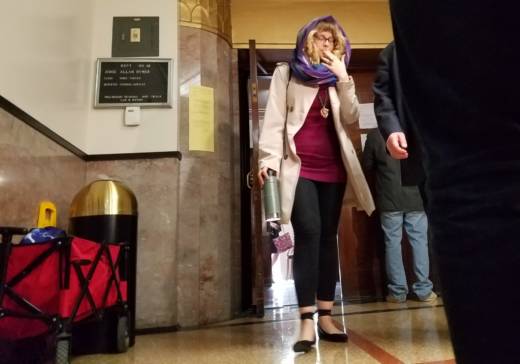Despite a lack of amenities, Vega said she became "amazingly more productive" with just a mattress on the floor -- a place to rest after late-night shifts as a bartender and caterer.
Vega said, "Hi, Tinsel," when prosecutor David Lim asked her to identify defendant Derick Almena, the master tenant of the building, who along with former resident Max Harris, is facing 36 counts of involuntary manslaughter. Vega explained "Tinsel" is a nickname of Almena's.
Prosecutors have sought to establish through Vega and other witnesses at preliminary hearings that began on Wednesday that Almena was in charge of the space, along with his second-in-command and "creative director," Harris.
But Vega and two other former residents have pushed back against those labels for the two defendants, instead describing an artists' collective with no clear leader or hierarchy.
"It's just a different system," Vega said. "We didn't have an 'in-charge.' We had a collective. We all did our best."
Former Ghost Ship resident Jose Avalos testified that Oakland police officers had been to the building multiple times.
"They came and they helped us evict people who just refused to leave," Avalos said. He also said an OPD officer would occasionally stop by the warehouse "to check on us" and was friendly with Almena.
Vega said the Satya Yuga art collective -- another name for the community at the warehouse -- grew "organically."
"This had become way more of an Oakland art movement that just landed on us," she said. The residents swelled to more than 20 people in 2016.
Vega began crying when Lim asked her about Peter Wadsworth, the only Ghost Ship resident to die in the fire. The other 35 people who died were attending a concert on Dec. 2, 2016, when the building caught fire.
"He died a horrible death," Vega said.
Avalos and Vega testified that they both gave money to Harris in exchange for living at the warehouse.
"I would bring it to Max and he would just hold it," she said, stating that she initially paid $250 and had last paid $1,400. "That's not like a fun job. It's full of drama and melodrama. Max was just such a sweetie pie."
When Lim asked her who invited her to live in the space, Vega answered, "The art community."
"The art community is a living, breathing entity beyond one person," she said. "Artists can rub two nickles together and make a dollar. Artists can make a city."
Satya Yuga: Origin of the Ghost Ship
Nicholas Bouchard testified he had a very different vision for the space when he co-signed a lease with Almena and Eva Ng, building owner Chor Ng's daughter, in late 2012. Max Harris didn't join the group until two years later.
Bouchard said he was part of the Satya Yuga art collective along with Almena and six or seven other people who set out to start a community center, which would eventually host after-school programs in addition to art and music events. The group moved a few RV's into the warehouse and immediately started living there, in violation of the lease conditions. He said he believed Eva Ng was aware people would be living in the warehouse, though.
But soon after signing the lease, he and Almena had a falling out, Bouchard said.
"Most of the decision making was done by Derick (Almena) at that time," he testified. "There was the tendency for plans to change depending on what Derick wanted."
That included cutting a large hole in the second floor, Bouchard said. He called a meeting of the group and invited his mother for advice on how to fundraise and bring the warehouse up to code.
"Derick showed up about two hours late, and when it came to talking about what we wanted to talk about, he scoffed," Bouchard testified.
He said he moved out of the warehouse three weeks after moving in.
"A lot of the reason for leaving was emotional as well," Bouchard said. "Derick had started heavily using speed and changing his behavior quite rapidly."
Bouchard said he hired an attorney to try to get out of the lease. He said he sent an email to Eva Ng notifying her that the lease conditions were being broken and that she should reclaim the property, but Ng did not agree to terminate the lease.
Curtis Briggs, Max Harris' defense attorney, pressed Bouchard on why, if he did not agree with what was happening at the warehouse, he didn't alert authorities. He appears to have made amends with Almena at some point and visited the warehouse several times, the last in August 2016.
"You wanted to protect yourself," Briggs said in court. "You didn't take any steps to protect anybody else."
Bouchard is scheduled to continue testifying on Monday.
